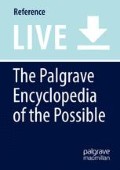Abstract
This entry approaches creativity as a possibility-testing and possibility-expanding phenomenon. It starts with a critical consideration of the definition of creativity in psychology, arguing that a study of the possible and impossible gets us closer to the nature of the creative process. Then it proceeds to analyse the relation between (im)possibility and creativity at the level of actors, actions, audiences, artefacts, and affordances. In each case, the focus is on (a) how these elements contribute to the engagement with the possible enabled by creative expression and (b) how they are transformed by the possibilities and impossibilities discovered along the way. The entry ends with reflections on the relationship between creativity and other possibility-expanding phenomena.
References
Corazza, G. E. (2017). Organic creativity for well-being in the post-information society. Europe's Journal of Psychology, 13(4), 599–605.
Dewey, J. (1934). Art as experience. New York: Capricorn Books.
Eco, U. (1989). Opera aperta. Cambridge, MA: Harvard University Press.
Galenson, D. W. (2011). Old masters and young geniuses: The two life cycles of artistic creativity. Princeton: Princeton University Press.
Gibson, J. J. (1986). The ecological approach to visual perception. Hillsdale: Lawrence Erlbaum Associates.
Glăveanu, V. P. (2011a). Creativity as cultural participation. Journal for the Theory of Social Behaviour, 41(1), 48–67.
Glăveanu, V. P. (2011b). Is the lightbulb still on? Social representations of creativity in a Western context. The International Journal of Creativity & Problem Solving, 21(1), 53–72.
Glăveanu, V. P. (2013). Rewriting the language of creativity: The five A’s framework. Review of General Psychology, 17(1), 69–81.
Glăveanu, V. P. (2014). The psychology of creativity: A critical reading. Creativity: Theories–Research–Applications, 1(1), 10–32.
Glăveanu, V. P. (2015a). From individual to co-agency. In C. W. Gruber, M. G. Clark, S. Hroar Klempe, & J. Valsiner (Eds.), Constraints of agency: Explorations of theory in everyday life (pp. 245–266). London: Springer.
Glăveanu, V. P. (2015b). Creativity as a sociocultural act. Journal of Creative Behavior, 49(3), 165–180.
Glăveanu, V. P. (2016). Affordance. In V. P. Glăveanu, L. Tanggaard, & C. Wegener (Eds.), Creativity: A new vocabulary (pp. 10–17). London: Palgrave.
Glăveanu, V. P. (2019). Creativity and wonder. Journal of Creative Behavior, 53(2), 171–177.
Glăveanu, V. P. (in press). The possible: A sociocultural theory. New York: Oxford University Press.
Glăveanu, V. P., Lubart, T., Bonnardel, N., Botella, M., de Biaisi, M.-P., Desainte-Catherine, M., Georgsdottir, A., Guillou, K., Kurtag, G., Mouchiroud, C., Storme, M., Wojtczuk, A., & Zenasni, F. (2013). Creativity as action: Findings from five creative domains. Frontiers in Educational Psychology, 4, 1–14.
Jovchelovitch, S., Priego-Hernandez, J., & Glăveanu, V. P. (2017). Imagination in children entering culture. In T. Zittoun & V. P. Glăveanu (Eds.), The handbook of imagination and culture (pp. 111–136). New York: Oxford University Press.
Karwowski, M., & Kaufman, J. C. (Eds.). (2017). The creative self: Effect of beliefs, self-efficacy, mindset, and identity. Waltham: Academic.
Kaufman, J. C., & Baer, J. (2004). The amusement park theoretical (APT) model of creativity. The International Journal of Creativity & Problem Solving, 14(2), 15–25.
Kaufman, J. C., & Glăveanu, V. P. (in press). Making the CASE for shadow creativity. Psychology of Aesthetics, Creativity, and the Arts.
Latour, B. (1991). Technology is society made durable. In J. Law (Ed.), A sociology of monsters: Essays on power, technology and domination (pp. 103–131). London: Routledge.
Runco, M. A., & Jaeger, G. J. (2012). The standard definition of creativity. Creativity Research Journal, 24(1), 92–96.
Smolucha, F. (1992). The relevance of Vygotsky’s theory of creative imagination for contemporary research on play. Creativity Research Journal, 5(1), 69–76.
Star, S. L., & Griesemer, J. (1989). Institutional ecology, ‘translations’, and boundary objects: Amateurs and professionals on Berkeley’s museum of vertebrate zoology. Social Studies of Science, 19, 387–420.
Sternberg, R. J., & Lubart, T. I. (2001). Wisdom and creativity. In J. E. Birren & K. W. Schaie (Eds.), Handbook of the psychology of aging (5th ed., pp. 500–522). San Diego, CA: Academic.
Stokes, P. D. (2005). Creativity from constraints: The psychology of breakthrough. New York: Springer.
Tahirsylaj, A. S. (2012). Stimulating creativity and innovation through Intelligent Fast Failure. Thinking skills and Creativity, 7(3), 265–270.
Vallée-Tourangeau, F., & March, P. L. (2019). Insight out: Making creativity visible. The Journal of Creative Behavior, early view.
Von Hippel, E. (2005). Democratizing innovation: The evolving phenomenon of user innovation. Journal für Betriebswirtschaft, 55(1), 63–78.
Vygotsky, L. S. (1990). Imagination and creativity in childhood. Soviet psychology, 28(1), 84–96.
Ward, S. M., Smith, T. B., & Finke, R. A. (1995). The creative cognition approach. Cambridge, MA: MIT Press.
Wertsch, J. V. (1998). Mind as action. Oxford: Oxford University Press.
Author information
Authors and Affiliations
Corresponding author
Section Editor information
Rights and permissions
Copyright information
© 2022 The Author(s), under exclusive licence to Springer Nature Switzerland AG
About this entry
Cite this entry
Glăveanu, V.P. (2022). Creativity. In: The Palgrave Encyclopedia of the Possible. Palgrave Macmillan, Cham. https://doi.org/10.1007/978-3-319-98390-5_158-2
Download citation
DOI: https://doi.org/10.1007/978-3-319-98390-5_158-2
Received:
Accepted:
Published:
Publisher Name: Palgrave Macmillan, Cham
Print ISBN: 978-3-319-98390-5
Online ISBN: 978-3-319-98390-5
eBook Packages: Springer Reference Behavioral Science and PsychologyReference Module Humanities and Social SciencesReference Module Business, Economics and Social Sciences
Publish with us
Chapter history
-
Latest
Creativity- Published:
- 13 September 2022
DOI: https://doi.org/10.1007/978-3-319-98390-5_158-2
-
Original
Creativity- Published:
- 01 June 2020
DOI: https://doi.org/10.1007/978-3-319-98390-5_158-1

